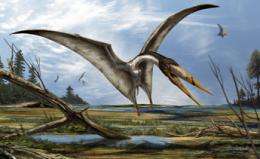Scientists find 95-million-year-old pterosaur fossil in Morocco

With the help of ancient fossils unearthed in the Sahara desert, scientists have identified a new type of pterosaur (giant flying reptile or pterodactyl) that existed about 95 million years ago. According to the findings published in the online peer-reviewed scientific journal PLoS ONE on May 26th, the scientists consider the newly identified pterosaur to be the earliest example of its kind.
Unearthed in three separate pieces, the jaw bone has a total length of 344mm (13.5 inches). Each piece is well preserved, uncrushed, and unlike most other pterosaur fossils, retains its original three dimension shape.
"This pterosaur is distinguished from all others by its lance-shaped lower jaw which had no teeth and looked rather like the beak of a heron," says Nizar Ibrahim, a PhD research scholar from University College Dublin, Ireland, who led the expedition. "During the excavation, we also discovered a partial neck vertebra that probably belonged to the same animal, inferring a wing span of about six metres."
The scientists have named the new pterosaur Alanqa saharicafrom the Arabic word 'Al Anqa' meaning Phoenix, a mythological flying creature that dies in a fire and is reborn from the ashes of that fire. On the same expedition, and in the same region as where the fossils of Alanqa saharica were uncovered, the scientists also discovered fossils of two other previously identified types of pterosaur. This suggests that several types of pterosaurs lived alongside one another in the same region at the time, each probably specializing in a different ecological niche.
"When this pterosaur was alive, the Sahara desert was a river bed basin lush with tropical plant and animal life," explains Ibrahim. "This means there were lots of opportunities for different pterosaurs to co-exist, and perhaps feeding on quite different kinds of prey."
Pterosaur bones are seldom preserved in the fossil record because they were light and flimsy in order to be optimized for flight. Until now there have been few significant pterosaur fossil finds in Africa.
More information: Ibrahim N, Unwin DM, Martill DM, Baidder L, Zouhri S (2010) A New Pterosaur (Pterodactyloidea: Azhdarchidae) from the Upper Cretaceous of Morocco. PLoS ONE 5(5): e10875. doi:10.1371/journal.pone.0010875
Provided by Public Library of Science




















